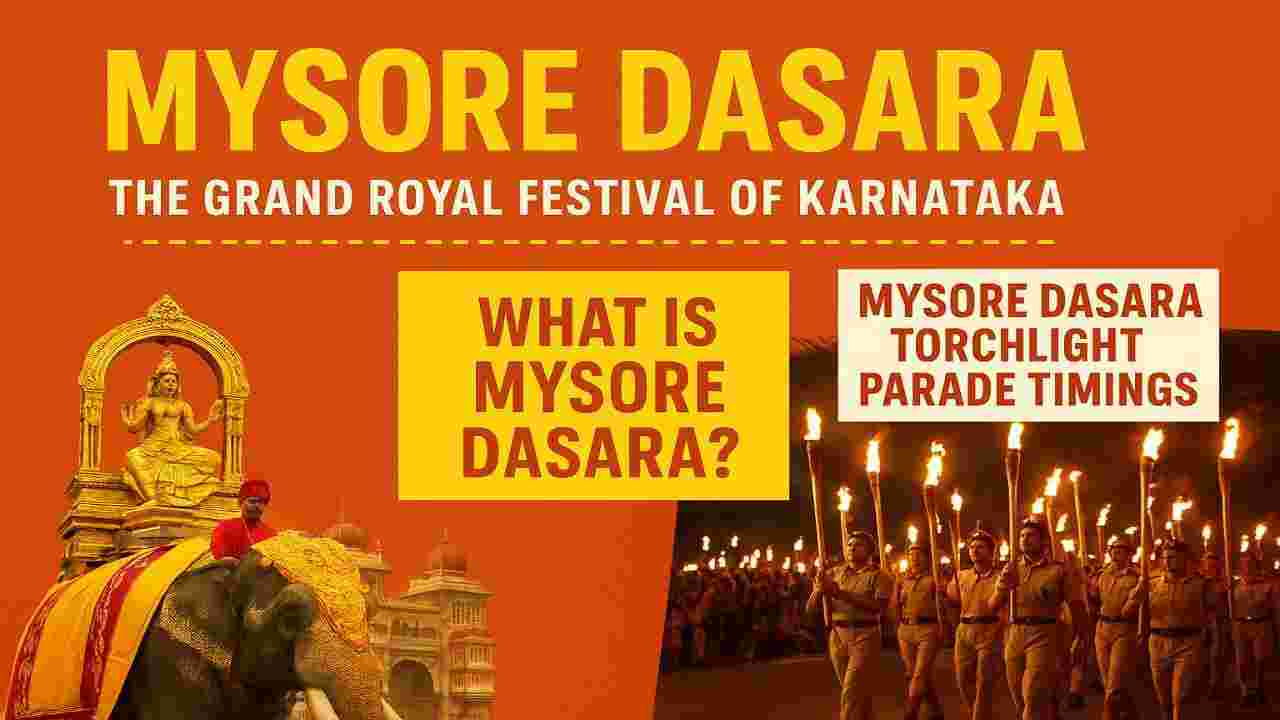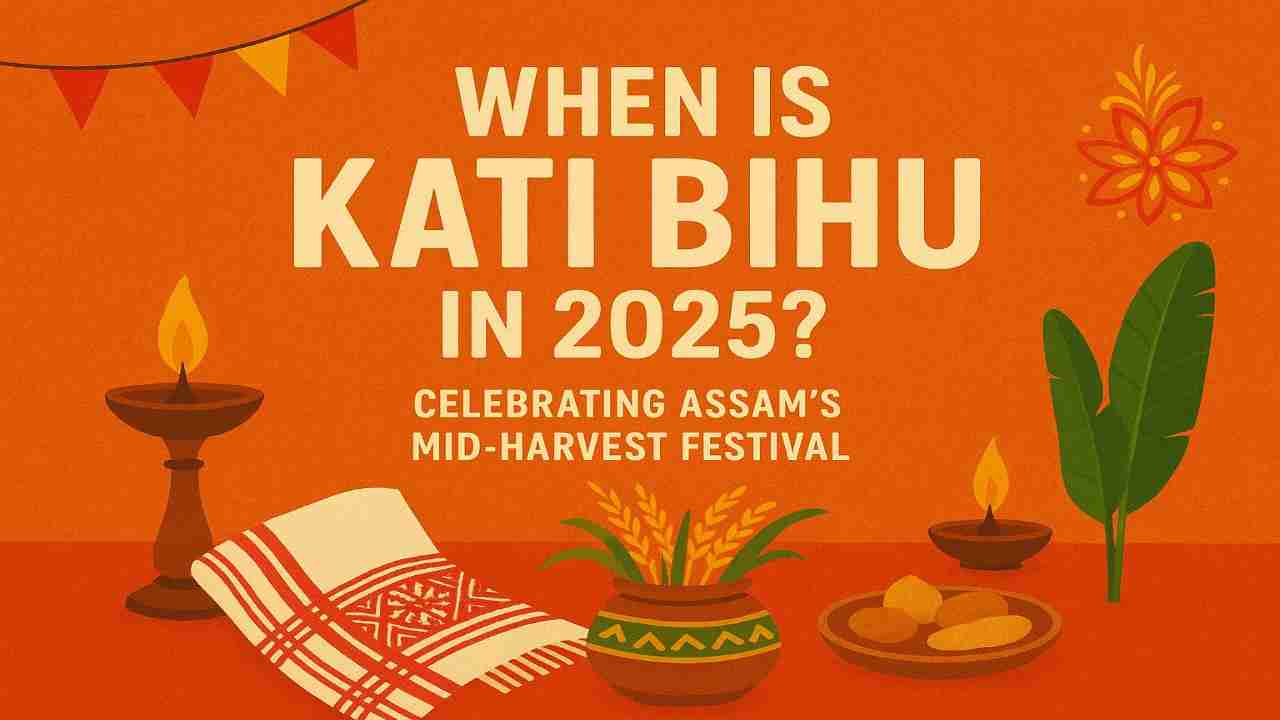
Have you ever wondered what makes the city of Mysore come alive with unparalleled grandeur every autumn? Every year, Karnataka celebrates Mysore Dasara, a festival that transforms the city into a cultural paradise of lights, devotion, and royal tradition. Often called the “Nadahabba” (state festival) of Karnataka, Mysore Dasara is more than just a celebration, it’s a living tradition that combines mythology, history, and vibrant cultural displays.
In this blog, we’ll explore what is Mysore Dasara, its mythological roots, royal significance, events, and the breathtaking Mysore Dasara Torchlight Parade timings that draw thousands of visitors from across the world.
What is Mysore Dasara?
Mysore Dasara is the grand celebration of Navratri and Vijayadashami in the southern city of Mysuru, Karnataka. While Navratri is celebrated across India in different ways, Mysore has given it a royal identity that is unmatched. The Wadiyar dynasty of Mysore began this tradition in the 15th century, and it continues to this day with the Mysore royal family presiding over the events.
At its heart, the festival commemorates the victory of Goddess Chamundeshwari (Durga) over the demon Mahishasura, symbolizing the triumph of good over evil. The city itself gets its name “Mysore” (Mysuru) from Mahishasura.
During the ten days of celebration, the city becomes a hub of devotion, music, dance, parades, exhibitions, and dazzling illumination of the iconic Mysore Palace.
Historical Roots of Mysore Dasara
The origins of Mysore Dasara can be traced back to the Wodeyar dynasty in the 15th century. King Raja Wodeyar I started the tradition in 1610, and since then, the Mysore Palace has remained the epicenter of celebrations.
Every ruler added unique rituals and grandeur to the festival, making it the cultural pride of Karnataka. Even today, the Wodeyar royal family actively participates, keeping alive centuries-old traditions.
The Devotion to Goddess Chamundeshwari
Central to Mysore Dasara is the worship of Chamundeshwari, the presiding deity of Mysore. The goddess is carried in a grand procession atop a golden howdah on a beautifully decorated elephant.
This event symbolizes the victory of the goddess over the demon Mahishasura, from whom the city derives its name: Mahishuru or Mysore. Devotees gather in large numbers to seek her blessings, making it a deeply spiritual experience.
Mythological Significance of Mysore Dasara
The story of Mysore Dasara is rooted in Hindu mythology:
- Mahishasura, the buffalo-headed demon, performed penance and gained a boon from Lord Brahma that no man could kill him.
- Empowered by this boon, he became arrogant and terrorized the three worlds.
- To restore balance, the gods combined their energies to create Goddess Durga.
- After a fierce nine-day battle, Durga killed Mahishasura on the tenth day, which came to be celebrated as Vijayadashami, the day of victory.
Thus, Mysore Dasara is not just a festival of joy but also a spiritual reminder of how good always triumphs over evil, and how divine feminine power protects the world.
The Royal Heritage of Mysore Dasara
The Mysore kings, especially Raja Wadiyar (early 17th century), formalized the celebration of Dasara in Mysore. Since then, the Wadiyar dynasty has preserved this tradition for centuries. Even today, the Mysore royal family actively participates, keeping the royal essence alive.
Highlights of royal traditions include:
- Worship at Chamundi Hill: On the first day, the scion of the Wadiyar family performs rituals to Goddess Chamundeshwari at the Chamundeshwari Temple.
- Private Durbar at Mysore Palace: A special royal court is held where the king sits on the golden throne (Simhasana), symbolizing his role as protector of dharma.
- Palace Illumination: The Mysore Palace is lit up with nearly 100,000 bulbs every evening, creating a breathtaking spectacle.
This blending of royal legacy and spiritual devotion makes Mysore Dasara unique in the world.
Events and Celebrations During Mysore Dasara
The ten-day festival is filled with rich cultural programs and iconic events. Let’s break down the highlights:
1. Cultural Programs
Dance, music, drama, and folk performances are organized at various venues across Mysore. Classical Carnatic and Hindustani musicians, Bharatanatyam dancers, and Yakshagana performers showcase India’s cultural diversity.
2. Exhibition at Doddakere Maidan
A massive exhibition with stalls selling handicrafts, textiles, traditional foods, and amusement rides attracts families and tourists alike.
3. Mysore Palace Illumination
Every evening during Dasara, the palace lights up between 7 PM and 10 PM, drawing thousands of visitors. The glowing palace against the night sky is one of the most photographed attractions of Mysore Dasara.
4. Yuva Dasara
A modern addition, Yuva Dasara is a youth-centric cultural program that features film stars, bands, and contemporary performances.
5. Ayudha Pooja
On the ninth day, tools, vehicles, and weapons are worshipped, symbolizing gratitude and reverence for objects of livelihood.
6. Vijayadashami Procession (Jumboo Savari)
The grand finale of the festival is the Jumboo Savari, the royal procession on Vijayadashami day.
- The idol of Goddess Chamundeshwari is placed in a golden howdah (weighing around 750 kg) on the back of a decorated elephant.
- The procession begins from Mysore Palace and travels to Bannimantap Grounds.
- Folk troupes, dancers, music bands, and decorated tableaux representing Karnataka’s culture add vibrance to the parade.
Mysore Dasara Torchlight Parade
The celebrations conclude with the Torchlight Parade, held at Bannimantap Grounds. This military-style event is one of the most awaited highlights.
Features of the Torchlight Parade:
- Mounted police, soldiers, and cultural troops participate.
- Acrobatic stunts, horse shows, and musical bands create a festive yet disciplined aura.
- The evening ends with a spectacular fireworks display and torch formations.
Mysore Dasara Torchlight Parade Timings
- The Torchlight Parade usually begins around 7:00 PM on Vijayadashami day at Bannimantap Grounds.
- Entry requires passes/tickets, which are in high demand.
- Visitors are advised to reach the venue early due to heavy crowds.
This grand finale symbolizes victory, valor, and celebration, leaving a lasting impression on every spectator.
Why You Should Experience Mysore Dasara
- Cultural Richness: From classical dances to modern concerts, Mysore Dasara offers a cultural extravaganza.
- Royal Grandeur: Witness centuries-old traditions of the Mysore royal family.
- Spiritual Significance: Experience rituals that honor Goddess Chamundeshwari.
- Visual Splendor: The illuminated palace, decorated elephants, and torchlight parade are once-in-a-lifetime sights.
- Global Appeal: The festival attracts tourists worldwide, making it a hub of cultural exchange.
Lessons from Mysore Dasara
- Good triumphs over evil: The story of Chamundeshwari inspires moral strength.
- Tradition sustains culture: Mysore Dasara shows how rituals and royal practices preserve identity.
- Unity in diversity: The festival brings together people of different communities and cultures.
- Balance of old and new: By blending classical performances with modern events like Yuva Dasara, the festival remains relevant for all generations.
Mysore Dasara is not just a festival; it’s a living heritage that brings mythology, history, and culture together. From the fierce story of Goddess Chamundeshwari slaying Mahishasura to the royal traditions of the Wadiyars, from the illuminated palace to the vibrant processions, Mysore Dasara is an experience like no other.
If you’ve ever asked, what is Mysore Dasara, the answer lies in its unmatched ability to combine devotion, grandeur, and cultural celebration. And don’t miss the breathtaking Mysore Dasara Torchlight Parade timings, the perfect climax to this unforgettable festival.
Want to dive into more mythological festivals of India? Check out our other blogs on Durga Puja and Ayudha Pooja.

